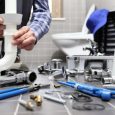 Log splitters are a vital tool for any woodcutting enthusiast. However, the engine must be in good condition and replaced when necessary for these devices to run correctly. This article will discuss when it is appropriate to replace the engine on a log splitter and provide information about how such replacements should be done. The key factors that determine if an engine needs replacing will be discussed, as well as guidance on the proper replacement procedure. With this advice, readers can ensure their log splitters remain in optimal condition for long-term use.
Log splitters are a vital tool for any woodcutting enthusiast. However, the engine must be in good condition and replaced when necessary for these devices to run correctly. This article will discuss when it is appropriate to replace the engine on a log splitter and provide information about how such replacements should be done. The key factors that determine if an engine needs replacing will be discussed, as well as guidance on the proper replacement procedure. With this advice, readers can ensure their log splitters remain in optimal condition for long-term use.
Overview Of Log Splitter Engines
Log splitters are powered by engines that use combustion to power the splitting blade. There is a variety of different engine types available, including four-stroke and two-stroke petrol engines as well as diesel engines. All these engines have a finite lifespan and will eventually require replacing due to normal wear and tear or other factors such as incorrect maintenance. As with any machinery, it is important to maintain log splitter engines in order to maximize their useful life before needing replacement. Regular servicing, oil changes, and proper fuel selection can help ensure the reliable operation of the engine over time.
Furthermore, paying attention to signs of impending failure can help prevent costly damage from occurring and minimize downtime associated with unexpected repairs or replacements. Knowing when best to replace an aging log splitter engine requires knowledge of typical lifespans for each type of engine used in this equipment, awareness of warning signs indicating imminent failure, and consideration of potential costs versus benefits for maintaining or replacing the log splitter’s engine.
How To Identify An Engine’S Condition
A log splitter engine should be checked regularly to ensure optimal operation and performance. There are several signs that can indicate when the engine is in need of replacement, such as reduced power output due to worn parts, excessive fuel consumption, or frequent breakdowns. When a log splitter’s engine begins losing power or has difficulty starting up, it is likely time for an engine replacement.
It can also be beneficial to check the spark plugs on the log splitter at regular intervals. If they appear blackened or heavily sooted, this could be an indication that the air/fuel mixture needs adjustment or cleaning. Worn-out spark plugs will require immediate replacement to ensure the proper functioning of the log splitter’s engine. Additionally, if there is visible smoke coming from the exhaust pipe after running the machine, this may signify a problem with piston rings which would require professional assessment and possible repair.
To avoid any potential issues with its engine over time, preventive maintenance should be undertaken routinely according to the manufacturer’s recommendations. This includes checking oil levels and changing filters periodically; replacing seals and other components as needed; assessing valve clearance; inspecting hoses for leaks; utilizing high-quality fuel for optimum operation; and ensuring all electrical connections are properly secure. Taking care of these tasks helps identify any potential problems before they cause significant damage, necessitating a complete log splitter engine replacement.
Reasons For Replacing An Engine
Engine replacement on a log splitter is an important maintenance task that should not be taken lightly. Wood splitters are designed to handle large amounts of wood with great efficiency, but the engine can suffer from wear and tear if it is not properly maintained. In order to ensure optimal performance, the engine must be replaced when necessary. There are several signs that indicate when it’s time for an engine replacement on your wood splitter, including decreased power output; increased vibration or noise; visible damage such as holes in the cylinder head; cracked cylinders; oil leaks; and excessive smoke. Additionally, if you notice reduced fuel efficiency or frequent stalls during operation, this could also be an indication that the engine needs to be replaced.
If any of these symptoms arise, it is best to have a qualified technician assess the situation and provide advice regarding whether the engine needs to be serviced or replaced entirely. It is important to note that replacing an engine will require some disassembly of the machine itself, so proper safety precautions should always be taken before attempting this type of repair job on a wood splitter. By following these guidelines and taking prompt action upon noticing any potential issues with your log splitter’s engine, you can help prevent more serious problems from occurring down the line and keep your equipment running at its peak performance level for many years to come.
Maintenance Tips To Prolong the Life Of Engine
Regular maintenance is essential to the longevity of a log splitter engine. A well-maintained engine will perform better and last longer than one that has been neglected. Regular oil changes should be done at least every three months or after 30 hours of operation, whichever comes first. Replacing air filters as needed can help ensure that the engine does not become clogged with debris. Additionally, cleaning and replacing spark plugs on a regular basis ensures proper combustion within the cylinders and helps prevent fouling from occurring due to carbon buildup. Keeping an eye out for any mechanical issues, such as loose belts or hoses, can also help prolong the life of an engine by avoiding major repairs in the future. Taking these steps to maintain your log splitter’s engine will help you avoid costly replacements down the line.
Finding The Right Replacement Parts
Replacing an engine on a log splitter is often necessary to keep the machine running. To ensure that the right type and size of parts are installed, it is important to check the manufacturer’s specifications. In some cases, if the wrong part is used, this can cause significant damage to both the engine and other components of the log splitter.
Before replacing an engine, all relevant details should be considered, including make and model number along with fuel type, for example, petrol versus diesel or electric versus manual start-up systems. Additionally, one must consider horsepower ratings as well as any additional features, such as tilt cylinders or rotating heads which may require specific parts. Furthermore, compatibility between new and old engines needs to be taken into account in order to prevent potential conflicts between different components. With these considerations in mind, selecting compatible replacement parts becomes easier so that they will fit correctly and work without issue when reassembling the log splitter following installation.
Benefits Of Upgrading Your Log Splitter Engine
Upgrading the engine of a log splitter has many advantages. The most significant benefit is an increase in power, both when splitting logs and transporting them. This increased power also allows for faster completion of work as well as more efficient use of resources such as fuel or electricity. Furthermore, upgrading one’s engine can provide better performance over time, with less maintenance required due to improved design features like reduced emissions and decreased noise levels. Finally, newer engines tend to be more reliable than older models thanks to their superior parts and components. Log splitters that have had their engines upgraded may end up lasting longer due to these improved designs and construction materials.
DIY Vs. Professional Repair/Replacement Options
Following the consideration of upgrading your log splitter engine, the question of how and when to replace a faulty or worn-out engine arises. It is important to understand that some repair/replacement tasks are best undertaken by professional mechanics with expertise in the maintenance and repair of engines used for log-splitting purposes.
On the other hand, there are cases where individuals can attempt DIY repairs and replacements without referring to experts. In these scenarios, it is essential to have access to quality replacement parts along with an appropriate toolkit for installation. Furthermore, having prior knowledge about the type of engine being replaced through research beforehand is also highly recommended, as this could help prevent any potential damage during the removal and replacement process. Additionally, if time allows, seeking advice from experienced professionals on proper methods for the successful completion of replacement would be beneficial.
Conclusion
Maintaining the engine of a log splitter is critical for its optimal functioning. To ensure that an engine continues to operate as it should, regular maintenance and timely replacement are necessary. It is important to understand when an engine needs replacing due to wear or damage in order to make sure that maximum performance is achieved from the log splitter. This understanding can come from evaluating the condition of the engine before making any decisions.




